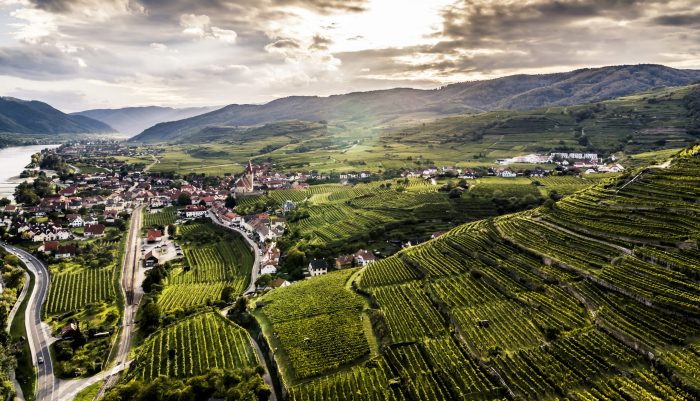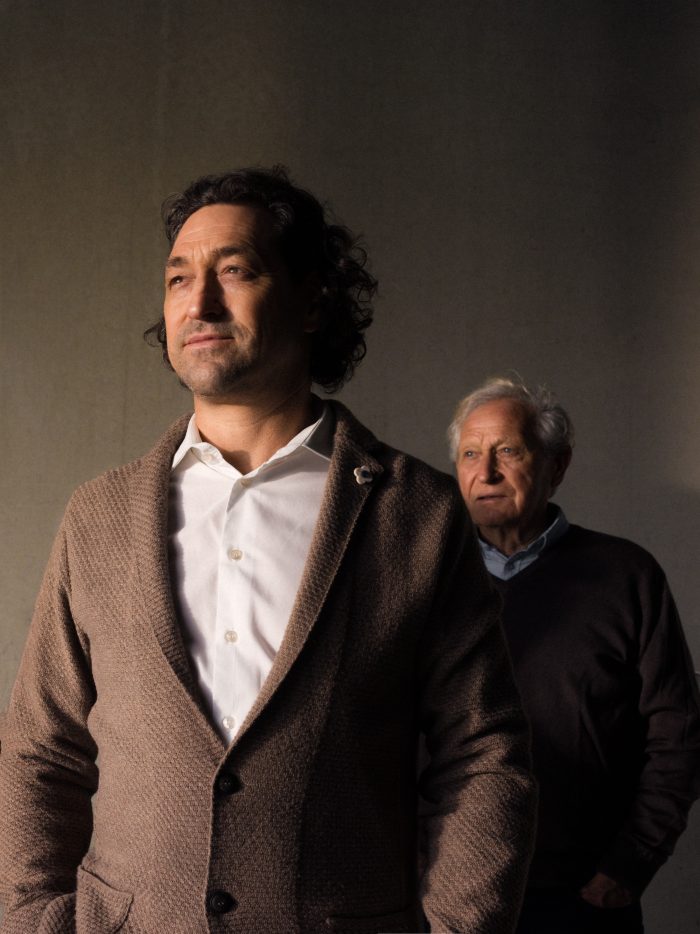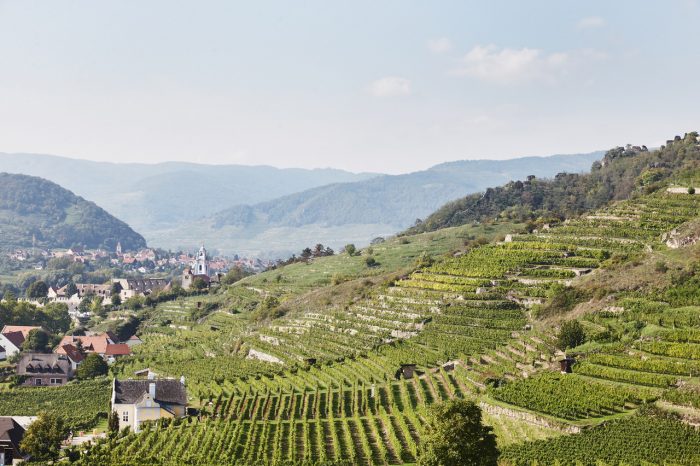Wachau’s iconic wines
Our new wines with a focus on the Wachau wine region can be found here:
Wachau, full of tradition and innovation
When it comes to tradition, the Wachau is definitely one of the top Austrian wine regions. In this UNESCO World Cultural Heritage valley grapes have been grown since the year 470 and is known for some of the best white wines in the world. However, that is not all: The recent implementation of the DAC system has brought considerable changes in the region, creating a parallel classification system to the well-known Steinfeder, Federspiel and Smaragd.
Where it all begun. The history of the Wachau
The westernmost wine growing region at the Danube consists of 1,291 hectares of plantings, covering both sides of the river from Melk to Krems, and it is full of tradition. Back in Roman times, viticulture was practiced in this narrow valley and even today, there is evidence of many centuries of vine growing, such as the dry-stone walls from the times of the Holy Roman Emperor Charlemagne (“Karl der Grosse”). Wachau was also one of the first wine regions in Austria to create very strict rules for marketing and guarantying top wine qualities through the creation of the private association “Vinea Wachau” back in the 80s. And now, since 2020 and after many years of discussions, a new era is starting with the possibility to market the wines with the Protected Denomination of Origin “Wachau DAC”, which is complementary to the Codex-Wachau brand-terms Steinfeder, Federspiel and Smaragd established by the Vinea Wachau, and unofficial quality pyramid until then.

The climate and its influence
The unique terroir of the lower Austrian wine region consists of a continental climate, which can also be described as a “Fjord” climate, due to the shape of the region. The Danube is the most important climate regulating element, which keeps the warmth during the day, besides reflecting the sunshine and contributing to the maturation of the grapes, especially those of the steepest and most appreciated vineyards. The pannonian influence in the eastern parts of the region is noticeable, comparing both eastern and western areas. Additionally, cooler influences during the night time of the forests located in the north the influence the climate significantly, resulting in wines that keep a fresh acidity and show a very fruity character.
The soils. A hidden treasure
Not only the climate, but also the soils in the Wachau are of extremely importance for the high quality of the wines. Gneiss (with the particular Gföhler gneiss), dark amphibolites of vulcanic origin, and some other poor and stoney metamorphic soils are found in the steep slopes of the region. Further down, loess, some clay, as well as sandy, sedimentary and alluvial rich soils are predominant. Therefore, the different types of soils result in a huge variety of single-vineyard wines with unique character.
The grape varieties
Many grape varieties are planted traditionally in the region but Grüner Veltliner and Riesling are the two stars and the most planted. Furthermore, Weissburgunder, Grauburgunder, Chardonnay, Neuburger, Muskateller, Sauvignon blanc, Traminer, Frühroter Veltliner, Müller-Thurgau, Muscat Ottonel, Roter Veltliner, and the three reds, Zweigelt, Blauburgunder and St. Lauren are also grown in the Wachau.
Wachau DAC. What is new?
Back in 2020, with the establishment of the Protected Denomination of Origin “Wachau DAC”, the wines produced with this unique terroir are eligible to carrying this designation. The wines under this appellation are classified by a three-level quality pyramid. On the bottom, the regional wines (Gebietswein) are found, which can be mono-varietals or blends (along with field blends: gemischter Satz) of all the grape varieties found in the region. Above, the village wines (Ortswein) are located, which can be made of Grüner Veltliner, Riesling, Weissburgunder, Grauburgunder, Chardonnay, Neuburger, Muskateller, Sauvignon blanc and Traminer. On the top of the pyramid, the single-vineyard wines (Riedenwein) or crus are found and they can only be made of Grüner Veltliner or Riesling, and no chaptalisation is allowed at this higher level. All the wines labeled as Wachau DAC have to be hand harvested, and the village, and single-vineyard wines can only have a little or no oak influence.
The coexisting quality and styles of the wines of the Wachau
This newly released DAC classification is therefore somehow similar to the prevalent Vinea Wachau quality levels. Nevertheless, the Vinea Wachau Steinfeder, Federspiel and Smaragd are based on the natural alcohol content of the harvested grapes (with no chaptalisation for any of the levels) and are not based on their terroir. Classifying the grapes by their natural alcohol content has been highly important in moderate and cool climate regions and this is still made in the Austrian or German Wine Law, such as in the Prädikatswein levels. However, this classification has been criticized and said to be obsolete, because due to global warming, the grapes get riper and the natural alcohol levels are on average higher than they used to be, which means that grape ripeness is not a real challenge anymore.


Eminences of the Wachau
A famous face behind that critic is the winery FX Pichler. Renowned for some of the most-wanted and finest wines of the Wachau, such as Unendlich, or the single vineyard wines Steinertal and Kellerberg, it has even been compared to the Wachau as Château Latour is in Bordeaux or DRC in Burgundy by Robert Parker. This Estate actually left the Vinea Wachau association, as its suggestions and requests for updating the brand terms were not accepted.
Following the list of the stars of the Wachau, some other outstanding wineries are Alzinger, Weinhofmasterei, Prager, or Franz Hirtzberger. This last producer shows year after year the potential of Riesling in this region with its iconic Riesling Singerriedel. This vineyard delivers some of the best, most concentrated Riesling grapes in the Wachau and it is with its 8 ha of south-west exposition and old paragneiss soils one of the most famous Riede.
Another wine estate worth mentioning is the Weingut Knoll, with its unmistakable label of the Pope Urban I and rich in tradition. This winery has been bottling in the best vintages a selection the best grapes within their several vineyards since the 50s in the Vinothekfüllung range and is known for some of the greatest sweet wines of the region.
Not only Wachau. The neighbors not to underestimate!
Leaving this extraordinary region slightly on a side, the neighboring Kremstal and Kamptal should not be really forgotten. The potential in these two region is comparable to the Wachau and there is a number of wineries that have been delivering great quality over decades too. The climate is quite similar to the Wachau, although due to the Panonnian influence, the tempratures in Kremstal are on average a bit higher. In Kamptal instead, the absence of the Donau is also remarkable, as well as cool winds of the north. Regarding the soils, these are comparable to the Wachau, especially in Kremtal, as Kamptal has a higher number of vineyards planted over loess.
The new future of the Wachau
Thus, the wine growing regions at the Danube with the outstanding Wachau in front bring some of the greatest, finest and most desirable white wines of Austria and the world, which now can be also marketed under the typicity of these regions. A step forward into the future.
Photocredit: Weingut FX Pichler, Robert Herbst/Vinea

